Garmin’s high-end watches come with both solar and non-solar charging options, letting you choose what fits your lifestyle. The solar models feature advanced Power Glass that captures sunlight to extend battery life, making them a great choice for those who spend a lot of time outdoors. However, the higher price tag raises an important question: is a Garmin solar watch worth it?
The answer varies from person to person and depends on how you plan to use the watch. To decide if the solar feature is worth the extra cost, consider your needs and whether the added benefits make sense for you.
Let’s explore the key points to help you make the best choice.
What is Solar on Garmin Watch?
Solar on Garmin watches refers to integrating solar charging technology that uses sunlight to extend battery life. Some Garmin watches particularly in their Forerunner and Fenix series come with solar technology, utilizing a Power Glass lens on the watch face.
This lens includes a thin rim around the edge of the display and a transparent film beneath the glass, which combine to convert sunlight into energy, helping extend battery life.
This feature was first introduced in 2019 with the Fenix 6X Pro. Early versions of solar charging provided only limited extra battery life, making it more of a novelty than a must-have.
However, with the Fenix 7 series, Garmin improved the efficiency of the solar panels and refined the watches’ power consumption, making solar charging a more practical and functional option.
Solar charging is designed to complement traditional charging, not replace it. Its primary purpose is to extend the time between charges, so users can focus on their activities without the constant concern of battery depletion.
Depending on sunlight exposure, solar technology can significantly enhance the longevity of the battery, especially during outdoor activities like running, hiking, or biking.
Key Benefits of Solar Charging on Garmin Watches:

- Extended Battery Life: Solar charging helps boost battery life, reducing the need for frequent charging during outdoor activities.
- Eco-Friendly: It utilizes renewable energy, making it environmentally friendly.
- Outdoor Advantage: For activities like hiking, running, or biking, solar charging allows users to keep their watch powered for longer during prolonged outdoor expeditions without access to a charger.
- Energy Saving: Depending on the model and how much sunlight it receives, solar can significantly extend the battery runtime of the watch.
Garmin watches with solar capabilities typically come with specific battery life estimates (for activities like GPS use or smart watch mode) based on solar charging to give users an idea of how much longer they can use their watch before needing a recharge.
Also See:- 9 Best GPS Watches with Map Display + Buyer’s Guide (2025).
Which Garmin Watches Have Solar?
Since the Fenix 6 series, several Garmin models have included solar variants. These include:
- Fenix
- Forerunner
- Instinct
- Edge
- Tactix
- Quatix
- Enduro
- Descent
This variety allows users to choose a solar watch suited to their needs.
What Conditions Make Solar Charging Most Effective?

The amount of extra battery life gained varies based on conditions. Garmin bases its battery estimates on watches receiving around 50,000 lux for three hours daily. To achieve this, the watch must:
- Face direct sunlight.
- Be free of screen protectors or other obstructions.
- Remain uncovered by clothing.
- Operate in optimal sunlight conditions, factoring in time of day, weather, and season.
- Stay within a temperature range of 0 to 60°C.
Solar charging works best in direct sunlight but also functions, to a lesser extent, under artificial light. For maximum efficiency, charging while the watch is off can also help.
How Much Extra Battery Life Can You Get?
The exact boost in battery life depends on the watch model and conditions. Here are some examples based on ideal sunlight exposure:
| Model | Solar Capability | Smartwatch Mode Battery Life |
|---|---|---|
| Forerunner 955(MIP Display) | Non-solar | Up to 15 days in smartwatch mode |
| Solar | Up to 20 days in smartwatch mode | |
| Fenix 8 (AMOLED dISPLAY) | Non-solar | Up to 16 days in smartwatch mode. |
| Solar | Up to 21 days in smartwatch mode. | |
| Instinct 2 | Non-solar | Up to 28 days in smartwatch mode. |
| Solar | Unlimited in smartwatch mode. |
In some cases, like the Instinct 2, the watch can last indefinitely under the right conditions. For others, solar charging may provide a 20% boost.
However, it’s worth noting that solar charging is much slower than plugging into an outlet, and ideal conditions aren’t always available.
For example, living in a cloudy region or spending most of your time indoors (like in an office) limits the benefits of solar.
On the other hand, if you’re hiking, camping, or outdoors for extended periods, solar can be a helpful feature.
What About the Price Difference?
Solar variants typically cost about $100 more than their non-solar counterparts. Here are a few examples:
Forerunner 955:
- Non-solar: $499
- Solar: $599
Instinct 2:
- Non-solar: $349
- Solar: $449
Fenix 8 (47mm):
- Both versions: $1,099
If you’re on a budget or don’t need the feature, a standard version or a portable charger may be better options.
Other Considerations
One potential drawback of solar models is the visible ring around the display. Some may find this distracting. Additionally, the extra layer on the screen may affect clarity.
Solar on Garmin Watch: Is It Worth the Extra Cost?
Whether solar is worth it depends on your lifestyle and the watch model. For example, solar offers limited benefits for Fenix users but can make a significant difference for Instinct 2 owners.
Solar is worth considering if you live in a sunny area or spend a lot of time outdoors. The extra power can greatly benefit activities like hiking, mountaineering, or endurance events.
On the other hand, if you’re indoors most of the time or live in a region with little sunlight, the feature may not be worth the extra cost. Garmin watches already have impressive battery life, and a portable charger might be a better investment.
Ultimately, it comes down to your specific needs and how you plan to use the watch.
You May Also Like:-
Explore great deals on Garmin solar watches at Garmin.com, or compare prices on Amazon.
Enjoyed this article? Subscribe to our monthly newsletter to stay updated on the latest tips, reviews, and deals!


